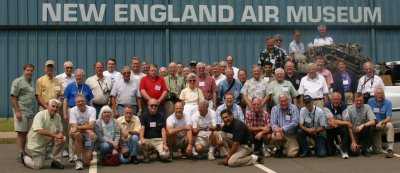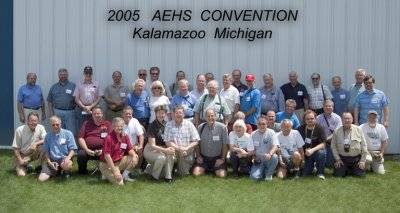
AEHS Convention Highlights 2004-2006
2006 Convention
Report from 3rd Annual Aircraft Engine Historical Society Convention
Windsor Locks, Connecticut (July 6-9, 2006)
by Larry Rinek
Program
 |
I flew from California to Connecticut in early July to attend the 3rd AEHS convention. The AEHS has several hundred members, with a fair number based overseas. Three attendees flew over from the UK and another arrived from Italy. The convention venue in Connecticut, just southeast of Bradley International Airport, was near Pratt & Whitney (P&W) HQ in East Hartford and the New England Air Museum (north side of airport in Windsor Locks), which we did explore at length. Around 55 hard-core aero engine enthusiasts ("motor heads") attended.
Upon the Thursday July 6 PM arrival, the group got acquainted over drinks, and an outdoor "Tiki Barbecue" at the Ramada hotel pool.
After introductory remarks on Friday AM July 7 by noted aero piston engine author/historian Mr. Graham White (who is also VP of the AEHS, as well as Torque Meter journal editor), the program began. All morning, the audience was enthralled with a panel session of P&W engineering retirees in their 80s, including Bob Toft, Bill McGaw, Phil Hopper, and Larry Carlson. Most of the panelists began at Pratt during the piston era in the early 1940s and retired in the jet era around the early 1980s. The panel was moderated by engineering retiree Jack Connors, who was hired in 1948 to work on Pratt gas turbines (Jack did a nice talk on the P&W J57 program at the 2005 AEHS convention in Kalamazoo, Michigan). Each retiree provided favorite recollections/ war stories, followed by an audience Q&A session.
The afternoon was devoted to an interesting guided tour of P&W's Customer Training facility (many production turbofans on display, such as PW 4168, PW 4090, PW 4460, PW 4000, PW 2037, and JT8D cutaway), followed by an unguided tour of the private P&W museum in East Hartford—not open to the public. I visited the East Hartford engineering offices around 1995 on official business as an aerospace consultant researching jet engine seals, and my father worked there from December 1941 to August 1945 in flight test as an engineering test pilot. That background qualifies me as a devoted P&W enthusiast.
Most of P&W's piston and early turbine engines were on display in the hidden Pratt museum, including the company's first water-cooled engine, the R-2060 "Yellow Jacket", a 20-cylinder/4-row radial. Not seen (stored away) were Pratt's experimental sleeve-valve water-cooled engines (such as the Navy XH-3130/3730, and Army X-1800) tabled in the early 1940s. Most convention attendees were particularly fond of the impressive and dependable P&W air-cooled radials on display, from the first R-1340 Wasp single-row radial of 1925, to the mighty R-4360 Wasp Major (4 rows of 7 cylinders)—the largest aircraft piston engine to reach mass production (in development all during World War II), and the exemplary R-2800 Double Wasp--which found volume post-war civil airliner markets (such as the DC-6 and Convair twins). Installed in latter P-47s with wartime emergency power (ADI), the R-2800 pulled 2,800 hp for 5-10 minutes, however one retiree panelist (Larry Carlson) ran one on the test stand up to 3,600 hp around 1944-1945 (engine survived). Got to love that high performance. The subsequent civil airliner R-2800 CA/CB series rated 2,500 hp at take off (water-methanol injection/ADI). The venerable R-2800, along with the R-1340 Wasp, finally went out of production in 1960. Warbird operators today have difficulty finding decent original WW II R-2800 engines to rebuild, so many civil R-2800s have been pressed into service.
The entire afternoon was dedicated to a walking tour of the New England Air Museum. This museum paid special homage to luminaries in Connecticut aviation history, with much on Sikorsky as well as P&W. A listing of its impressive collections can be seen at www.neam.org. I visited there many years ago while at P&W (1995), and many new exhibits were evident now. Among the less common aircraft on display, was a well-restored gleaming B-29 bomber. Other warbirds on display indoors included: P-47, F6F, F-86, F-100, F-14, and more. Many engines (piston and turbine), were also on display—including some P&W engines NOT seen at the P&W museum (one example: R-1535 Twin Wasp Junior). I was impressed with a clean Hall-Scott A-2 pushrod 60 hp V-8 of 1910 on display, built in Berkeley, CA. That engine (along with the V-8s of Glenn Curtiss) competed directly with my family's Rinek model B-10, a 60 hp water-cooled pushrod V-8 of 1910 (one example survives today in the Yorkshire Air Museum, UK).
We got a private tour to see some un-restored engines/airframes in storage, including a rare GE I-16 (Whittle-type) centrifugal-compressor turbo jet, that brought the U.S. into the jet age around 1944, as well as the hot P&W J58 that powered the Mach 3+ SR-71. Another ultra-rare engine in storage (only one built, it ran once and then seized) was an Allison air-cooled V-12 built under contract for the Army. This was reportedly the first Allison aero engine design.
Kevin Cameron, technical writer and tech editor of Cycle World as well as columnist for the quarterly AEHS Torque Meter, was the esteemed after-dinner speaker for the annual banquet on Saturday night. He is renowned for his clear articulation of technical issues, such as the details of engine design and related materials of construction, so that everybody can understand them—while interjecting some humor to such tech topics.
Sunday July 9th began with a flourish as Mr. Pete Law, Lockheed Skunk Works veteran and an annual legend in the pits at the Reno National Air Races spoke at length. Pete worked on engineering thermodynamics challenges for the SR-71 program, among others at the Lockheed Skunk Works, and he knew top bosses Clarence (Kelly) Johnson and Ben Rich fairly well. At Reno, dating from the present back to 1964 origins, Pete became the go-to-guy for engineering problems on carburetors, cooling, ADI (water/methanol injection) systems, and ram air recovery designs. Countless teams have relied on Pete, including Darryl Greenamyer's famous modified F8F Bearcat unlimited gold champion, the Rare Bear (stuffed with an enhanced Wright R-3350 radial, and still the world speed record holder for piston-driven propeller aircraft), the Red Baron P-51 Mustang (stuffed with a R-R Griffon), a Super Corsair, and Tsunami, among others. Pete gave an unforgettable overview of Reno's unlimited racers, from 1964 to 2005.
AEHS plans more conventions at other venues: most likely at Dayton, Ohio near the Air Force Museum in late July 2007, and then a convention on the West Coast/Southern California—probably near the Planes of Fame Museum in Chino. All together, a well-received gathering this year, and attendance was up over 2005.
2006 Convention Presentations
NOTICE: Due to abusive robotic downloading of AEHS 2006 Convention presentations by non-members,
Presentations by Pete Law |
2005 Convention
Program
 |
Fifty-two aircraft engine enthusiasts attended the Second Annual AEHS Convention in Kalamazoo, Michigan. Some started arriving as early as Wednesday afternoon July 20, but the majority of attendees arrived on Thursday. Informal conversations in and around the registration process have become a major highlight of the convention. Many try to arrive early for this lagniappe that is fast becoming a tradition. Such conversations continued through the day, the reception, and into the wee hours of the following morning. This year we placed tables along one wall of the conference room where numerous show-and-tell items were placed. The arrival of these items was another Thursday attraction, as were several swap tables, where attendees displayed books and memorabilia for sale or trade.
Formal sessions began on Friday with Clen Thomlinson's comments on some of the non-obvious problem of designing and building operating scale models of historic engines. Next up was Tom Fey, whose survey of controllable pitch propeller mechanisms, aided by some real parts furnished by the Kalamazoo Air Zoo, underscored the incredible cleverness of propeller designers.
Bud Wheeler led off the Friday afternoon session by describing his path to becoming one of the world's top Allison overhaulers—the special tools, instrumentation, test rigs, fixtures, processes and products he has developed to keep Allisons flying. Jack Connors then described the world of Pratt & Whitney when Luke Hobb's team developed the award-winning J57.
All through the day, numerous lively discussions arose during the breaks and lunch. These did not end with dinner, but again continued until the wee hours of Saturday morning. It is unfortunate these conversations were not recorded for posterity—they were that good!
During the first Saturday session, Pete Law described his long association with air racing, and his even longer association with the Lockheed Skunk Works. Next, Kevin Cameron discussed combustion, detonation and the evolution of aircraft engine cooling.
Highlights of the Saturday afternoon visit to the Kalamazoo Air Zoo were highlighted by Pete Law's explanation of the Lockheed SR-71 that he helped develop and of the Pratt & Whitney J58 that powered it, examination of the Curtiss XP-55 Ascender undergoing restoration, and the running of a Guiberson diesel engine that sounded like, well, a radial Diesel!
Sunday's first session was devoted to a question and answer session with Pete Law. The last convention session culminated with an auction of donated memorabilia that raised several hundred dollars for the AEHS.
The AEHS convention is a rare and wonderful thing — an opportunity to share knowledge and enthusiasm about aircraft engine history that is unparalleled anywhere.
Napier Delta and Sabre Model Galleries
2005 Convention Presentations
NOTICE: Due to abusive robotic downloading of AEHS 2005 Convention presentations by non-members,
J57 - Pratt & Whitney's Little Engine that Could - by Jack Connors |
2004 Convention